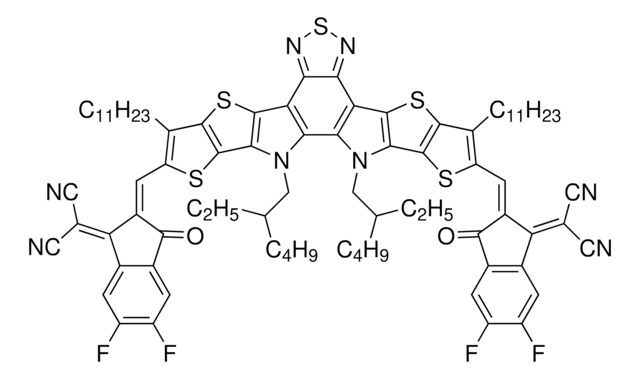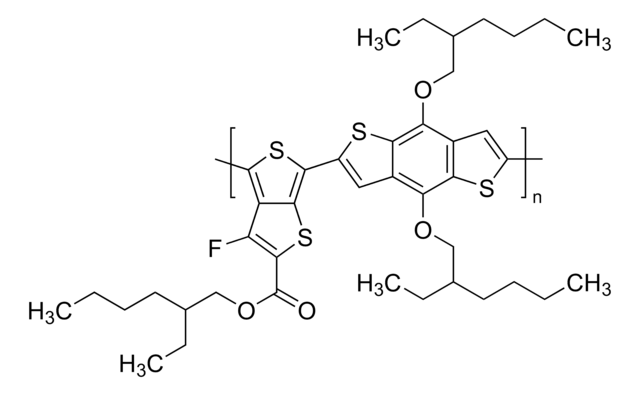901067
PBDTTT-C-T
Sinónimos:
Poly[[4,8-bis[5-(2-ethylhexyl)-2-thienyl]benzo[1,2-b:4,5-b′]dithiophene-2,6-diyl][2-(2-ethyl-1-oxohexyl)thieno[3,4-b]thiophenediyl]]
About This Item
Productos recomendados
descripción
Band gap: 1.86 eV
Nivel de calidad
Ensayo
≥99% trace rare earth metals basis
Formulario
solid
mol peso
Mw 80,000-150,000 (GPC, PS standard)
características de los productos alternativos más sostenibles
Design for Energy Efficiency
Learn more about the Principles of Green Chemistry.
sustainability
Greener Alternative Product
mp
>200 °C
solubilidad
chlorobenzene: soluble
chloroform: soluble
dichlorobenzene: soluble
Energía orbital
HOMO -5.11 eV
LUMO -3.25 eV
PDI
≥2.0
categoría alternativa más sostenible
, Enabling
Descripción general
Código de clase de almacenamiento
11 - Combustible Solids
Clase de riesgo para el agua (WGK)
WGK 3
Punto de inflamabilidad (°F)
Not applicable
Punto de inflamabilidad (°C)
Not applicable
Elija entre una de las versiones más recientes:
Certificados de análisis (COA)
¿No ve la versión correcta?
Si necesita una versión concreta, puede buscar un certificado específico por el número de lote.
¿Ya tiene este producto?
Encuentre la documentación para los productos que ha comprado recientemente en la Biblioteca de documentos.
Artículos
Novel biosensing devices, like bio-FET sensors, offer label-free analysis by detecting ionic and biomolecular charges, crucial for diagnostics and biological research.
Explore the eco-friendly potential of organic thin film transistors (OTFTs) for detecting chemical analytes, identifying viruses, and assisting in health diagnostics. This mini-review highlights challenges of achieving sustainability, safety, and biodegradability of each component of an OTFT sensor.
Professor Chen (Nankai University, China) and his team explain the strategies behind their recent record-breaking organic solar cells, reaching a power conversion efficiency of 17.3%.
Nuestro equipo de científicos tiene experiencia en todas las áreas de investigación: Ciencias de la vida, Ciencia de los materiales, Síntesis química, Cromatografía, Analítica y muchas otras.
Póngase en contacto con el Servicio técnico






![Poly[(9,9-dioctylfluorenyl-2,7-diyl)-co-bithiophene] 99.9%](/deepweb/assets/sigmaaldrich/product/structures/309/000/8b4a3f54-7765-4aca-96c4-74ce328d455d/640/8b4a3f54-7765-4aca-96c4-74ce328d455d.png)

